Beautiful Indian Architecture Sculpture and Pottery 2024
Indian Architecture Sculpture and Pottery. The word ‘architecture’ is derived from the Latin word ‘tekton’ which means builder So’ as soon as the early man began to build his or her shelter to live in, the science of architecture started.
Sculpture on the other hand’ is derived from proto indo European Root ‘kel’ which means ‘to cut or cleave’ sculptures are smaller works of art’ either handmade or with tools.
Difference between architecture and sculpture
Architecture
It refers to the design and construction of buildings
Architecture uses a mixture of various types of materials like stone, wood, glass, metal, sand, etc.
It involves study of engineering [mathematics ] requires accurate Measurement.
Example: Taj Mahal, Rad fort etc.
Sculpture
These are relatively smaller 3-dimensional works of art.
A single piece of sculpture made of a single type of material.
*Sculpture involves creativity and imagination and does not depend as heavily on accurate measurements.
Example: Natraj’s image, dancing girl etc.
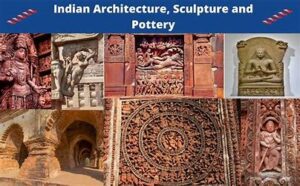
Indian Architecture Sculpture and Pottery
It’s a story of evolution, from the ancient Harappa Valley civilization to British rule. The invention of foreign rulers who gradually became indigenous, the confluence of different cultures and styles etc. are all reflected in the evolution of Indian art and sculpture
Classification of Indian Architecture Sculpture and Pottery [Ancient India]
Harappan Art.
Mauryan, Art.
Post Mauryan art.
Gupta Age.
South Indian Art.
Indian Architecture Sculpture and Pottery in mediaeval India.
Delhi Sultanate
Mughal Art.
Indian Architecture Sculpture and Pottery in modern India.
Indo Gothic style.
Neo Roman style.
Harappan Indian Architecture Sculpture and Pottery
A flourishing civilization emerged [2600 BC to 1900 BC] on the banks of the river Indus. A marked feature of this ancient civilization was a vivid imagination, and artistic sensibilities exuded by the numerous sculptures, seals, potteries, jewelries, found at the excavation sites. Harappa and Mohenjo-Daro – the two major sites of the civilization, are among the earliest and finest example of urban civic
Planning The planned network of roads, houses and drainage developed during those time
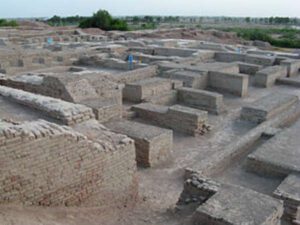
Important sites of the Indus Valley civilization and their archaeological findings.
Harappa in present Pakistan on the Bank of River Revi. from here found, two rows of six granaries with a big platform, Stone symbol of lingam and Yoni, Mother goddess figure, Wheat and barley in wooden mortar, Dice, Copper, scale and mirror, Sculpture of dog changing our dear in bronze medal, red sandstone male torso have been excavated.
Indian Architecture Sculpture and Pottery evidence found during excavation at Mohenjo — Daro. it is In present Pakistan on the river Indus. item found here, The citadel, The Great Bath, The Great Granary, Post cremation burial, Sculpture of a bearded priest, Famous bronze statue of the dancing girl, Pasupathi seal.
Dholavira
Dholavira is also an important site from the point of view Indian Architecture Sculpture and Pottery. of Indus valley civilization Many objects of the Indus Valley civilization have been found here as well. Dholavira is in Gujarat. from here found, Giant water is reservoir, Unique water harnessing system, Stadium, Dams and embankments, Inscription.
Lothal
Lothal is also an Indus valley site.it is very important point of view Indian Architecture Sculpture and Pottery. it is in Gujarat. Items obtained from here, Dockyard, Practice of burial of cremated remains, Rice husk, Fire altars, Painting jars, Modern day chess, Terracotta figure of horse and ship, Instrument measuring 45,.90 and 180° angles.
Rakhigarhi
In Haryana, is considered to be the largest side of Indus Valley civilization. granary, Cemetery, Drains have been found here.
Roper
Ropar is an important place of Indian architecture sculpture and pottery in ancient time it is located on the banks of Sutlej in Punjab. items found during excavation from roper, Dog buried with human oval pit burials Cooper axe
Balathal and Kalibangan
Balathal and Kalibangan is also a place of Indian architecture sculpture and pottery in ancient. it is in Rajasthan from here found,
Bangle factory, toy carts, bones of camels, decorated bricks, Citadel and Lower town, Fire altar
Surkotada
Surkotada is also a important site point view Indian Architecture Sculpture and Pottery.it
is in Gujarat, first from here we found, actual remains of the horse bones.
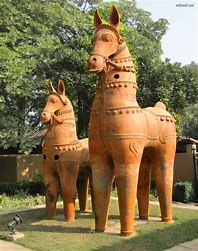
Banawali
point of view Indian Architecture Sculpture and Pottery Banawali is important site. it is In Haryana on the dried Sarasvati River. the item which were obtained from here, Toy plough, Barley grains, lapis lazuli, fire altars only, city with radial streets
Alamgirpur
from Alamgirpur, Broken blade, made of copper, Ceramic items, impression of a cloth on a through
Mehrgarh
from Mehrgarh, Pottery, copper tools have been found.
Indian Architecture Sculpture and Pottery, Architecture in Harappan civilization.
Harappan and Mohenjo Daro reveal a remarkable sense of town planning in a rectangular grid pattern. Roads run in north-south and east West direction, cutting each other at right angles.
three types of buildings have been found in the excavation sites.
Dwelling house
Public buildings.
Public baths.
in Indian Architecture Sculpture and Pottery, The Harappans Used burnt mud bricks for the purpose of construction using Gypsum Mortal.
The city was divided into two parts — appraised citadel and the lower part, an apprised citadel in the western part, was used for constructing buildings of large dimension, such as granaries. administrative buildings, pillared halls, courtyard, some of the buildings un citadel might have been the residence of the rulers and aristocrats.
The granaries were intelligently designed with strategic air ducts and raised platforms which helped in protecting them from pests.
Important feature of the Harrapan. cities is the prevalence of public baths which indicated ritualistic and cleansing in their culture. The baths also had galleries and rooms surrounding it. For example— a great bath.
In the lower part of the city, small one roomed house has been found used by the working-class people. Some of the houses have stairs means they were double stories
.Most buildings have private buildings and bathrooms and another feature of Harappan civilization is advanced drainage system, small drains from each house connected to the large one and also covered loosely to allow regular cleaning and
maintenance
The importance placed on hygiene both personal and public, is quite impressive Indian Architecture Sculpture and Pottery,
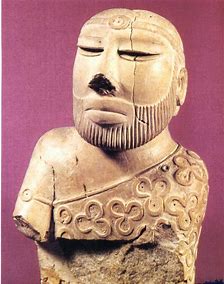
Sculpture of Harappan civilization.
three dimensional volumes
Seals
Bronze figures
Potteries
Seals
Archaeologists have found numerous seals of different shapes and sizes all across the excavation sites.
While most sales are square, it was found that triangular, Rectangular and circular sales were also used
Steatite, a soft stone found in the riverbeds
Sine Instances of copper, gold and ivory sales have also been found. Seale
Animal impressions were also there
The common animals were Unicorn, Rhinoceros, tiger, elephant, Buffalo bison, goat crocodile etc. However, no evidence of cow
Some seals had figures on bath side and some had inscriptions on the other side, and some had inscriptions on both sides and Sam had inscriptions on the 3rd side as well.
Mathematics images have been found on some seals which might. Hell been used for educational purposes as well.
Seals with symbols similar to swastika design have also been found.
For example, Pasupathi seals
Bronze figure
The bronze statues were made using “lost wax technique” or “cire perdue” In this technique, wax figures are coated with wet clay and allowed to dry, then clay coated figures are heated, allowing the wax inside to melt. The wax is poured out through a tiny hole and liquid metal is poured inside after the metal has cooled down, the clay Coat is removed, and the metal figure of the same shape is obtained.
For example-Prawns dancing girl of Mohenjo Daro
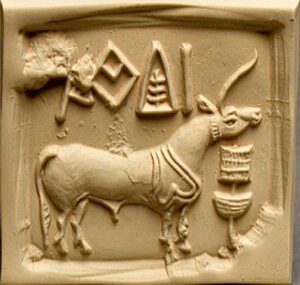
Terracotta
Terracotta refers to the use of fire baked clay for making sculptures. Compared to the bronze figures, the terracotta sculptures are less in number and crude. In shape and form.
Have been found mostly in the sites of Gujarat and Kalibangan.
Terracotta was generally used to make toys, animal figures, miniatures, carts and Wheels etc.
For example, the Mother Goddess figure.
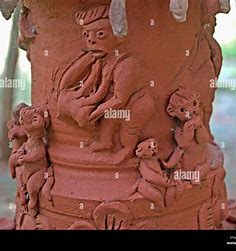
Pottery
Founded pottery classified into two kinds “plane pottery and painting pottery, portrait, painted pottery also known as red and black, red color used to paint the background and black Paint used to draw figures in the red background like trees, birds, animal figures and Geometric patterns.
*The potteries were used for three main purposes
*Household purpose to store grains and water* Decorative purposes*Some potteries were perforated. Large holes in the bottom and small holes across the sides have been used for straining liquor.
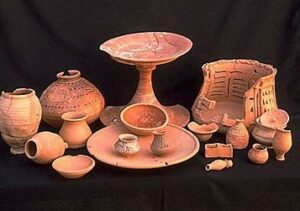
Ornaments.
The Harappan used a large variety of materials from precious metal and gemstones stones to bones and even baked clay to make ornaments
Both men and women wore ornaments like Necklaces, fillets, armlets and figure fingerings, girdles, earrings and anklets were worn only by women. *Beads made from cornelian, amethyst, quartz, steatite etc. Were quite popular and produced on a large scale, as is evident from the factories discovered in Chanhu Daro and Lothal.
For fabric, the Harappans used Cotton and wool. The people of that time were conscious of fashion as well, as can be inferred from the different style. Of hair and beard. For example-Bearded priest, red sandstone
Conclusion
Welcome to Indra Digi is a platform where you can get information about the Indian Architecture Sculpture and Pottery. Here you see the endless art and cultural wonders of India and celebrate the past, present and future of this magnificent heritage.
thank you
Comments
Post a Comment